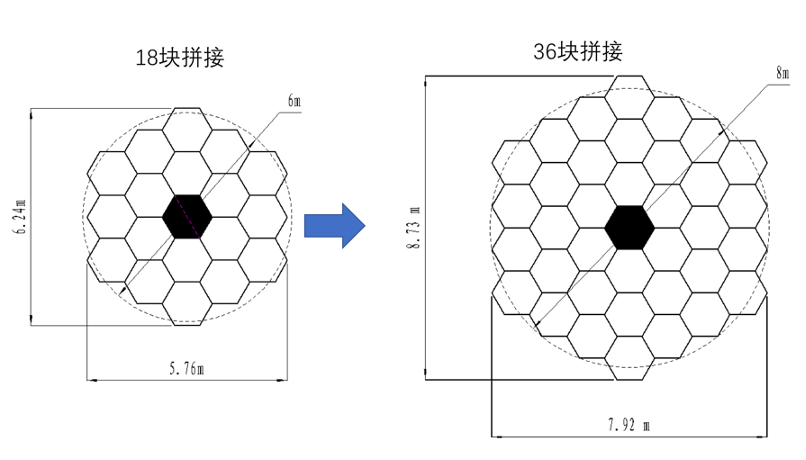
A rendering of the final form of the Expandable Aperture Segmented Telescope (EAST)
(Image credit: Nanjing Institute of Astronomical Optics & Technology, CAS/Peking University)
Peking University is leading a joint effort to build an Expandable Aperture Segmented Telescope (EAST) with the largest aperture, segmented mirror in Asia in 2024-2030, to quickly narrow the huge gap between China and foreign countries in the size of optical telescopes, and to meet the urgent needs of Chinese astronomers for diversified optical astronomical observations. The construction will be carried out in two phases according to the expanding mirror aperture (6 meters and 8 meters respectively), which will greatly improve the observational capability of optical astronomy in China, provide necessary conditions for the follow-up optical observations of the upcoming China Space Station Telescope (CSST), the existed Five-hundred-meter Aperture Spherical radio Telescope (FAST) and other telescopes, and produce the first-class scientific achievements in probing our universe. It will also accumulate valuable technical experiences for the future constructions of larger aperture ground-based optical telescopes and the launch of large space segmented optical telescopes.
Astronomy has a long history in China and contributed significantly to the Chinese culture, civilization and science. Now astronomy also plays an irreplaceable role in the strategic, scientific, and social development of China. It adopts the most advanced observational technology to obtain information from the universe, enabling humans to explore some of the most fundamental scientific problems in the universe. As it involves abundant technologies of optics, machinery, electronics, detector, computer, AI, and data sciences, a large astronomical telescope is an important symbol of a country's scientific and technological development level. At present, optical telescopes with an aperture of more than 6 meters are mainly owned by the United States, Europe, and Japan, and located in America, Europe, and Africa. The largest aperture is about 10 meters, including Keck and HET in the United States, GTC in Europe, and SALT in South Africa. Most of these telescopes are general-purpose telescopes, which are the main driven forces of major astronomical discoveries. For example, the 2020 Nobel Prize in Physics was awarded to scientists who discovered the supermassive black hole in the center of the Milky Way using the Keck (two 10-meter telescopes) in the United States and the VLT (four 8-meter telescopes in Chile) owned by Europe.
Currently, the largest optical telescope in China is the Large Sky Area Multi-Object Fiber Spectroscopic Telescope (LAMOST) with an effective aperture of 4 meters, but it is a specific telescope only used for spectroscopic sky survey. The largest aperture of the domestic general-purpose optical telescope is the 2.4-meter telescope in Lijiang, Yunnan, and the 2.16-meter telescope in Xinglong, Hebei, which are much smaller than those in other developed countries. China has the world-class equipment in the radio and high-energy wavebands, such as the Five-hundred-meter Aperture Spherical radio Telescope (FAST), the High Altitude Cosmic Ray Observatory LHAASO, and the X-ray satellite HXMT. However, the lack of large optical telescopes has seriously hindered the overall development of Chinse astronomy. Observations at other wavebands often require follow-up observations by large optical telescopes to confirm their scientific values. The upcoming launch of China Space Station Telescope (CSST) with a 2-meter-aperture and the Wide-Field Survey Telescope (WFST) with a 2.5-meter-aperture to be built in Lenghu, Qinghai, both require a larger aperture general-purpose optical telescope for the follow-up observations. In the future, the construction of ground-based optical/near-infrared telescopes with an aperture of 15-30 meters and the launch of space segmented optical telescopes with an aperture of more than 6 meters will also require the technological experiences of ground-based large segmented telescopes. Therefore, it is very urgent and necessary to build a 6-8 meter aperture general-purpose optical telescope with the largest segmented mirror in Asia as soon as possible.

A schematic shows the two phases of the mirror of the proposed Expandable Aperture Segmented Telescope (EAST).
(Image credit: Nanjing Institute of Astronomical Optics & Technology, CAS/Peking University)
The 6-8 meter general-purpose optical telescope adopts the segmented mirror technology, which can be constructed in two phases for a total of 7 years. In the first phase (the first five years, 2024-2028), the supporting frame and dome will be built, and the main mirror will be segmented by 18 hexagonal mirrors (the sub-mirror size is 1.44 meters), with a diameter of about 6 meters (5.76 * 6.24 meters) and the effective aperture of 5.5 meters. In the second phase (the next two years, 2029-2030), 18 more hexagonal segments will be added in the outer part, expanding it to a diameter of about 8 meters (7.92 * 8.73 meters) and the effective aperture of 7.8 meters. The first phase of focal plane instruments includes imaging cameras and low-medium resolution imaging spectrometers, and the second phase includes high-resolution spectrometers, multi-object spectrometers, polarimeter, and adaptive optical systems. The total cost of the project is estimated to be 500 to 600 million Chinese yuan.
EAST will be built in the Lenghu area in Haixi Prefecture, Qinghai Province, which is located at the northern edge of the Qaidam Basin, with a clear night sky, abundant sunshine, convenient traffic conditions, and a good regional security environment. A domestic site selection team has carried out three-year comprehensive monitoring of the parameters of the Lenghu Saishiteng Mountain site at an altitude of 4200 meters, and obtained a large number of data including atmospheric visibility, skylight background, the ratio of the observable clear night, weather, dust, atmospheric turbulence, and settleable water vapor. The skylight background without a moon at the site of Saishiteng Mountain is darker than 22 magnitude per square arcsecond, the proportion of high-quality clear nighttime is about 70%, and the median value of seeing is 0.75 arcseconds. With these superior basic parameters, it is indeed a rare site of a world-class optical observatory in the eastern hemisphere.

The sky over the Saishiteng Mountain of Lenghu, Qinghai (photo taken by Jeff Dai)
The construction of a 6-8m EAST telescope in Lenghu will not only provide Chinese astronomers an advanced telescope for the scientific frontier research on the universe, but also offer more opportunities and conditions for international collaborations in astronomy. For example, we can do the global relay observations of important astronomical phenomena (due to the alternation of day and night in the eastern and western hemispheres) and the timely observations of important transient astronomical events (they can be observed only in the eastern hemisphere if the western hemisphere is in daytime). We expect that the EAST telescope can help us probe more secrets of our universe!

The locations of optical telescopes with aperture larger than 8m in the world. EAST telescope will be the only one in the eastern hemisphere.
(Image credit: Nanjing Institute of Astronomical Optics & Technology, CAS/Peking University)
We sincerely expect your support and help!
For more information and possible donation, please contact pkuastronomy@pku.edu.cn!
